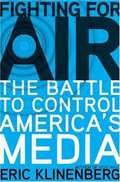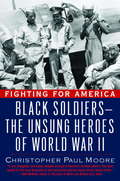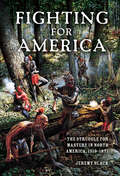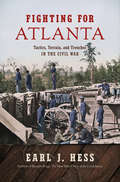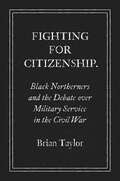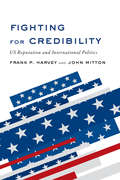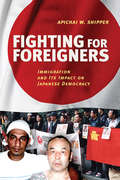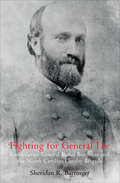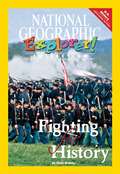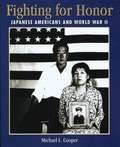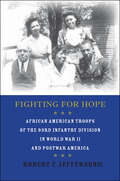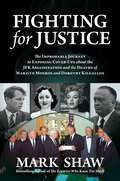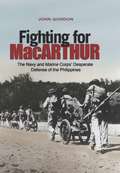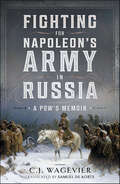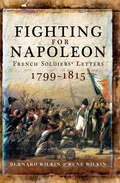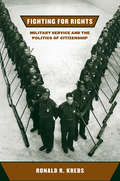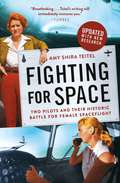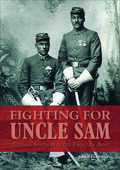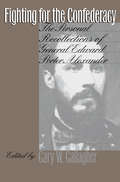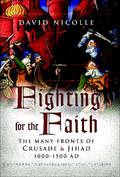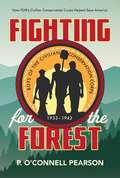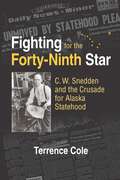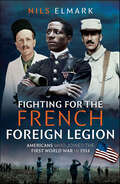- Table View
- List View
Fighting for Air: The Battle to Control America's Media
by Eric KlinenbergA groundbreaking investigative work by a critically acclaimed sociologist on the corporate takeover of local news and what it means for all Americans For the residents of Minot, North Dakota, Clear Channel Communications is synonymous with disaster. Early in the morning of January 18, 2002, a train derailment sent a cloud of poisonous gas drifting toward the small town. Minot's fire and rescue departments attempted to reach Clear Channel, which owned and operated all six local commercial radio stations, to warn residents of the approaching threat. But in the age of canned programming and virtual DJs, there was no one in the conglomerate's studio to take the call. The people of Minot were taken unawares. The result: one death and more than a thousand injuries. Opening with the story of the Minot tragedy, Eric Klinenberg's "Fighting for Air" takes us into the world of pre-programmed radio shows, empty television news stations, and copycat newspapers to show how corporate ownership and control of local media has remade American political and cultural life. Klinenberg argues that the demise of truly local media stems from the federal government's malign neglect, as the agencies charged with ensuring diversity and open competition have ceded control to the very conglomerates that consistently undermine these values and goals. Such "big media" may not be here to stay, however. "Fighting for Air" delivers a call to action, revealing a rising generation of new media activists and citizen journalists-- a coalition of liberals and conservatives-- who are demanding and even creating the local coverage they need and deserve.
Fighting for America: Black Soldiers-the Unsung Heroes of World War II
by Christopher Paul MooreThe African-American contribution to winning World War II has never been celebrated as profoundly as in Fighting for America. In this inspirational and uniquely personal tribute, the essential part played by black servicemen and -women in that cataclysmic conflict is brought home. Here are letters, photographs, oral histories, and rare documents, collected by historian Christopher Moore, the son of two black WWII veterans. Weaving his family history with that of his people and nation, Moore has created an unforgettable tapestry of sacrifice, fortitude, and courage. From the 1,800 black soldiers who landed at Normandy Beach on D-Day, and the legendary Tuskegee Airmen who won ninety-five Distinguished Flying Crosses, to the 761st Tank Battalion who, under General Patton, helped liberate Nazi death camps, the invaluable effort of black Americans to defend democracy is captured in word and image. Readers will be introduced to many unheralded heroes who helped America win the war, including Dorie Miller, the messman who manned a machine gun and downed four Japanese planes; Robert Brooks, the first American to die in armored batt Lt. Jackie Robinson, the future baseball legend who faced court-martial for refusing to sit in the back of a military bus; an until now forgotten African-American philosopher who helped save many lives at a Japanese POW c& even the author's own parents: his mother, Kay, a WAC when she met his father, Bill, who was part of the celebrated Red Ball Express. Yet Fighting for America is more than a testimonial; it is also a troubling story of profound contradictions, of a country still in the throes of segregation, of a domestic battleground where arrests and riots occurred simultaneously with foreign service-and of how the war helped spotlight this disparity and galvanize the need for civil rights. Featuring a unique perspective on black soldiers, Fighting for America will move any reader: all who, like the author, owe their lives to those who served.
Fighting for America: The Struggle for Mastery in North America, 1519–1871 (Encounters: Explorations in Folklore and Ethnomusicology)
by Jeremy Black&“Fascinating . . . [a] 300-plus year history of North America&” from the award-winning historian and author of The Holocaust: History & Memory (Military Heritage). Prize-winning author Jeremy Black traces the competition for control of North America from the landing of Spanish troops under Hernán Cortés in modern Mexico in 1519 to 1871 when, with the Treaty of Washington and the withdrawal of most British garrisons, Britain accepted American mastery in North America. In this wide-ranging narrative, Black makes clear that the process by which America gained supremacy was far from inevitable. The story Black tells is one of conflict, diplomacy, geopolitics, and politics. The eventual result was the creation of a United States of America that stretched from Atlantic to Pacific and dominated North America. The gradual withdrawal of France and Spain, the British accommodation to the expanding U.S. reality, the impact of the American Civil War, and the subjugation of Native peoples, are all carefully drawn out. Black emphasizes contingency not Manifest Destiny, and reconceptualizes American exceptionalism to take note of the pressures and impact of international competition. &“A refreshing take on Manifest Destiny . . . American (and Canadian) readers will learn a lot of new things and be led into new ways of viewing old ones. An important contribution.&”—Walter Nugent, author of Into the West: The Story of Its People
Fighting for Atlanta: Tactics, Terrain, and Trenches in the Civil War (Civil War America)
by Earl J. HessAs William T. Sherman's Union troops began their campaign for Atlanta in the spring of 1864, they encountered Confederate forces employing field fortifications located to take advantage of rugged terrain. While the Confederates consistently acted on the defensive, digging eighteen lines of earthworks from May to September, the Federals used fieldworks both defensively and offensively. With 160,000 troops engaged on both sides and hundreds of miles of trenches dug, fortifications became a defining factor in the Atlanta campaign battles. These engagements took place on topography ranging from Appalachian foothills to the clay fields of Georgia's piedmont.Leading military historian Earl J. Hess examines how commanders adapted their operations to the physical environment, how the environment in turn affected their movements, and how Civil War armies altered the terrain through the science of field fortification. He also illuminates the impact of fighting and living in ditches for four months on the everyday lives of both Union and Confederate soldiers. The Atlanta campaign represents one of the best examples of a prolonged Union invasion deep into southern territory, and, as Hess reveals, it marked another important transition in the conduct of war from open field battles to fighting from improvised field fortifications.
Fighting for Citizenship: Black Northerners and the Debate over Military Service in the Civil War (Civil War America)
by Brian TaylorIn Fighting for Citizenship, Brian Taylor complicates existing interpretations of why black men fought in the Civil War. Civil War–era African Americans recognized the urgency of a core political concern: how best to use the opportunity presented by this conflict over slavery to win abolition and secure enduring black rights, goals that had eluded earlier generations of black veterans. Some, like Frederick Douglass, urged immediate enlistment to support the cause of emancipation, hoping that a Northern victory would bring about the end of slavery. But others counseled patience and negotiation, drawing on a historical memory of unfulfilled promises for black military service in previous American wars and encouraging black men to leverage their position to demand abolition and equal citizenship. In doing this, they also began redefining what it meant to be a black man who fights for the United States.These debates over African Americans' enlistment expose a formative moment in the development of American citizenship: black Northerners' key demand was that military service earn full American citizenship, a term that had no precise definition prior to the Fourteenth Amendment. In articulating this demand, Taylor argues, black Northerners participated in the remaking of American citizenship itself—unquestionably one of the war's most important results.
Fighting for Credibility: US Reputation and International Politics
by Frank P. Harvey John MittonWhen Bashar al-Assad used chemical weapons against his own people in Syria, he clearly crossed President Barack Obama’s "red line." At the time, many argued that the president had to bomb in order to protect America's reputation for toughness, and therefore its credibility, abroad; others countered that concerns regarding reputation were overblown, and that reputations are irrelevant for coercive diplomacy. Whether international reputations matter is the question at the heart of Fighting for Credibility. For skeptics, past actions and reputations have no bearing on an adversary’s assessment of credibility; power and interests alone determine whether a threat is believed. Using a nuanced and sophisticated theory of rational deterrence, Frank P. Harvey and John Mitton argue the opposite: ignoring reputations sidesteps important factors about how adversaries perceive threats. Focusing on cases of asymmetric US encounters with smaller powers since the end of the Cold War including Bosnia, Kosovo, Iraq, and Syria, Harvey and Mitton reveal that reputations matter for credibility in international politics. This dynamic and deeply documented study successfully brings reputation back to the table of foreign diplomacy.
Fighting for Foreigners: Immigration and Its Impact on Japanese Democracy
by Apichai W. ShipperAlthough stereotypically homogenized and hostile to immigrants, Japan has experienced an influx of foreigners from Asia and Latin America in recent decades. In Fighting for Foreigners, Apichai W. Shipper details how, in response, Japanese citizens have established a variety of local advocacy groups-some faith based, some secular-to help immigrants secure access to social services, economic equity, and political rights.Drawing on his years of ethnographic fieldwork and a pragmatic account of political motivation he calls associative activism, Shipper asserts that institutions that support illegal foreigners make the most dramatic contributions to democratic multiculturalism. The changing demographics of Japan have been stimulating public discussions, the political participation of marginalized groups, and calls for fair treatment of immigrants. Nongovernmental organizations established by the Japanese have been more effective than the ethnically particular associations formed by migrants themselves, Shipper finds. Activists who initially work in concert to solve specific and local problems eventually become more ambitious in terms of political representation and opinion formation.As debates about the costs and benefits of immigration rage across the developed world, Shipper's research offers a refreshing new perspective: rather than undermining democracy in industrialized society, immigrants can make a positive institutional contribution to vibrant forms of democratic multiculturalism.
Fighting for General Lee: Confederate General Rufus Barringer and the North Carolina Cavalry Brigade
by Sheridan R. BarringerRufus Barringer fought on horseback through most of the Civil War with General Lees Army of Northern Virginia, and rose to lead the North Carolina Cavalry Brigade in some of the wars most difficult combats. Fighting for General Lee: Confederate General Rufus Barringer and the North Carolina Cavalry Brigade details his entire history for the first time.Barringer raised a company early in the war and fought with the 1st North Carolina Cavalry from the Virginia peninsula through Second Manassas, Sharpsburg, Fredericksburg, and Chancellorsville. He was severely wounded in the face at Brandy Station, during the opening hours of the Gettysburg Campaign. Because of his severe wound, he missed the remainder of the Gettysburg Campaign, returning to his regiment in mid-October, 1863. Within three months he was a lieutenant colonel, and by June 1864 a brigadier general in command of the North Carolina Brigade, which fought the rest of the war with Lee and was nearly destroyed during the retreat from Richmond in 1865. The captured Barringer met President Lincoln at City Point, endured prison, and after the war did everything he could to convince North Carolinians to accept Reconstruction and heal the wounds of war.Fighting for General Lee by Sheridan R. Barringer draws upon a wide array of newspapers, diaries, letters, and previously unpublished family documents and photographs, as well as other firsthand accounts, to paint a broad, deep, and colorful portrait of an overlooked Southern cavalry commander. Despite its subject matter, the book is a balanced account that concludes Barringer was a dependable, hard-hitting warrior increasingly called upon to lead attacks against superior Union forces.This remarkable new biography teaches us many things. It is easy today to paint all who wore Confederate gray with a broad brush because they fought on the side to preserve slavery. Here, however, was a man who wielded the sword and then promptly sheathed it to follow a bolder vision. Barringer proved to be a bold champion of the poor, the black, and the massesa Southern gentleman and man decades ahead of his time that made a difference in the lives of North Carolinians.
Fighting for History (National Geographic Explorer Collection)
by Peter WinklerNIMAC-sourced textbook
Fighting for Honor: Japanese Americans and World War II
by Michael L. CooperAn account of Japanese Americans in World War II, based mainly on diaries, autobiographies, and the military records of the 442nd Regimental Combat Team, which was known as the Purple Heart Battalion because of its bravery. After the attack on Pearl Harbor in 1941, all people on the West Coast of Japanese heritage, whether resident aliens or citizens, were forced to move into internment camps. But 1,200 young men from the camps, along with 10,000 other GIs of Japanese heritage, became some of the most decorated soldiers in the war as part of the 442nd. Author Michel L. Cooper tells of the remarkable bravery of these Nisei soldiers, whose heroism in battles in Europe contrasted with the prejudice that Japanese Americans faced at home.
Fighting for Hope: African American Troops of the 93rd Infantry Division in World War II and Postwar America (War, Society, Culture Ser.)
by Robert F. Jefferson“A rigorously researched, richly etched re-creation of the formation of the all-black Ninety-third Infantry Division, which fought in the Pacific theater.” —Journal of American HistoryThis fascinating history shows how African-American military men and women seized their dignity through barracks culture and community politics during and after World War II.Drawing on oral testimony, unpublished correspondence, archival records, memoirs, and diaries, Robert F. Jefferson explores the curious contradiction of war-effort idealism and entrenched discrimination through the experiences of the 93rd Infantry Division. Led by white officers and presumably unable to fight—and with the army taking great pains to regulate contact between black soldiers and local women—the division was largely relegated to support roles during the advance on the Philippines, seeing action only later in the war when U.S. officials found it unavoidable.Jefferson discusses racial policy within the War Department, examines the lives and morale of black GIs and their families, documents the debate over the deployment of black troops, and focuses on how the soldiers’ wartime experiences reshaped their perspectives on race and citizenship in America. He finds in these men and their families incredible resilience in the face of racism at war and at home and shows how their hopes for the future provided a blueprint for America’s postwar civil rights struggles.Integrating social history and civil rights movement studies, Fighting for Hope examines the ways in which political meaning and identity were reflected in the aspirations of these black GIs and their role in transforming the face of America.“A marvelous book.” —Annals of Iowa
Fighting for Hope: African American Troops of the 93rd Infantry Division in World War II and Postwar America (War/Society/Culture)
by Robert F. JeffersonThis fascinating history shows how African-American military men and women seized their dignity through barracks culture and community politics during and after World War II.Drawing on oral testimony, unpublished correspondence, archival records, memoirs, and diaries, Robert F. Jefferson explores the curious contradiction of war-effort idealism and entrenched discrimination through the experiences of the 93rd Infantry Division. Led by white officers and presumably unable to fight—and with the army taking great pains to regulate contact between black soldiers and local women—the division was largely relegated to support roles during the advance on the Philippines, seeing action only later in the war when U.S. officials found it unavoidable. Jefferson discusses racial policy within the War Department, examines the lives and morale of black GIs and their families, documents the debate over the deployment of black troops, and focuses on how the soldiers’ wartime experiences reshaped their perspectives on race and citizenship in America. He finds in these men and their families incredible resilience in the face of racism at war and at home and shows how their hopes for the future provided a blueprint for America’s postwar civil rights struggles.Integrating social history and civil rights movement studies, Fighting for Hope examines the ways in which political meaning and identity were reflected in the aspirations of these black GIs and their role in transforming the face of America.
Fighting for Justice: The Improbable Journey to Exposing Cover-Ups about the JFK Assassination and the Deaths of Marilyn Monroe and Dorothy Kilgallen
by Mark Shaw&“Investigative reporting at its best. Mark Shaw&’s original work into the questionable deaths of Marilyn Monroe and Dorothy Kilgallen is now focused on the many unanswered questions left by the Warren Commission&’s inquiry into the JFK assassination. Fighting for Justice has to be read.&” —Nicholas Pileggi, author of Wiseguy and Casino Packed with shocking new evidence, Fighting for Justice exposes the cover-ups of the JFK assassination and the murders of Dorothy Kilgallen and Marilyn Monroe, while revealing for the first time the corrupt inner workings of the Warren Commission based on the firsthand &“whistleblower&” account of an actual Commission member never identified before.How does an explosive &“whistleblower&” account from a Warren Commission (WC) member never identified before destroy once and for all the biggest lie in American history, the &“Oswald Alone&” theory? On what basis did the member admit, &“It&’s more than Oswald. There is internal corruption on the Commission. I do not agree with the Report&”? Is the &“whistleblower&” the same one who surreptitiously passed Jack Ruby&’s WC testimony to journalist Dorothy Kilgallen prior to its release date? And how did President Lyndon Johnson and J. Edgar Hoover strong arm the commission to prevent any investigation of the truth about who killed JFK and why? Based on fifteen years of research, answers to these questions and more are uncovered in Fighting for Justice, bestselling author and noted historian Mark Shaw&’s improbable journey to exposing cover-ups of the JFK assassination while proving Marilyn Monroe and Kilgallen were murdered.
Fighting for MacArthur
by John GordonAs the only single-volume work to offer a full account of Navy and Marine Corps actions in the Philippines during World War II, this book provides a unique source of information on the early part of the war. Based on a rich collection of American and newly discovered Japanese sources, it is filled with never-before-published details about the fighting, including a revealing discussion of the buildup of tensions between Gen. Douglas MacArthur and the Navy that continued for the remainder of the war.Gordon describes in considerable detail the unusual missions of the Navy and Marine Corps in the largely Army campaign, where sailors fought as infantrymen alongside their Marine comrades at Bataan and Corregidor, crews of Navy ships manned the Army's heavy coastal artillery weapons, and Navy submarines desperately tried to supply the men with food and ammunition. Indeed, this book gives the most detailed account ever published of the Japanese bombing of the Cavite Navy Yard outside Manila on the third day of the war-the worst damage inflicted on a U.S. Navy installation since the British burned the Washington Navy Yard in 1814. It also closely examines the surrender of the 4th Marines at Corregidor, the only time in history that the U.S. Marine Corps lost a regiment in combat. To provide readers with a Japanese perspective of the fighting, Gordon draws on the recently discovered diary of a leader of the Japanese amphibious assault force that fought against the Navy's provisional infantry battalion on southern Bataan, and he also makes full use of the U.S. ship logs and the 4th Marine unit diary that were evacuated from Manila Bay shortly before U.S. forces surrendered.
Fighting for Napoleon's Army in Russia: A POW's Memoir
by C.J. WagevierIn 1812 the French emperor Napoleon decided to invade Russia. For this purpose, he gathered an army of half a million men and women, consisting of soldiers from all nationalities, including French, German and Italian. Serving in this army was Carel Johannes Wagevier, an officer in the 125th Regiment of the Line, which was staffed by mostly Dutch soldiers. Full of confidence, they went to war and began the long journey to the East. What followed was a horrific expedition deep into the Russian interior, a chaotic retreat, and captivity. Just like his fellow soldiers, Wagevier endured the cold, the stresses of combat, and the hunger that besieged the army. After fighting at the battle of Berezina in November 1812, he was taken prisoner and transported all the way to the Russian interior. In 1814 he and his remaining fellow officers were released, and together they started the journey back home. During his travels across Russia, he made notes of events that occurred or meetings that seemed memorable, including ones of unexpected generosity as well as sudden cruelty. These notes were later expanded into his memoir and published in 1820. Now, for the first time ever, they have been translated into English, providing a unique and fascinating insight into the life of a solider in Napoleon’s army.
Fighting for Napoleon: French Soldiers' Letters, 1799–1815
by Bernard Wilkin René WilkinTrue, first-hand accounts of combat and soldiering from the men who fought for Napoleon Bonparte and the First French Empire: &“Fascinating stuff&” (Stuart Asquith, author of Military Modelling). The French side of the Napoleonic Wars is often presented from a strategic point of view, or in terms of military organization and battlefield tactics, or through officers&’ memoirs. Fighting for Napoleon:French Soldiers&’ Letters, 1799–1815, based on more than sixteen hundred letters written by French soldiers of the Napoleonic armies, shares the perspectives and experiences of the lowest, ordinary ranks of the army who fought on the frontlines. Authors Bernard Wilkin and René Wilkin provide an informative read of common soldiers&’ lives for military and cultural historians as well as a fascinating counterpoint to the memoirs of Cpt. Jean-Roch Coignet, Col. Marcellin de Marbot, or Sgt. Adrien Bourgogne. &“A superb guide to the experience and motivation of military service that is based on a wide trawl of relevant letters . . . A first-rate work that is of much wider significance.&” —Professor Jeremy Black, author of The Battle of Waterloo &“Provides the reader with a good insight into the lives of ordinary French of the Napoleonic Wars . . . Direct accounts of campaigns and battle, recruitment and training, barrack life, the experience of captivity and being wounded are all here, based on letters written most by uneducated men to their immediate family . . . This really is fascinating stuff, and surely a &‘must&’ for students of Napoleonic warfare.&” —Stuart Asquith, author of Military Modelling: Guide to Solo Wargaming
Fighting for Rights: Military Service and the Politics of Citizenship (Cornell Studies in Security Affairs)
by Ronald R. KrebsLeaders around the globe have long turned to the armed forces as a "school for the nation." Debates over who serves continue to arouse passion today because the military's participation policies are seen as shaping politics beyond the military, specifically the politics of identity and citizenship. Yet how and when do these policies transform patterns of citizenship? Military service, Ronald R. Krebs argues, can play a critical role in bolstering minorities' efforts to grasp full and unfettered rights. Minority groups have at times effectively contrasted their people's battlefield sacrifices to the reality of inequity, compelling state leaders to concede to their claims. At the same time, military service can shape when, for what, and how minorities have engaged in political activism in the quest for meaningful citizenship. Employing a range of rich primary materials, Krebs shows how the military's participation policies shaped Arab citizens' struggles for first-class citizenship in Israel from independence to the mid-1980s and African Americans' quest for civil rights, from World War I to the Korean War. Fighting for Rights helps us make sense of contemporary debates over gays in the military and over the virtues and dangers of liberal and communitarian visions for society. It suggests that rhetoric is more than just a weapon of the weak, that it is essential to political exchange, and that politics rests on a dual foundation of rationality and culture.
Fighting for Space: Two Pilots and Their Historic Battle for Female Spaceflight
by Amy TeitelSpaceflight historian Amy Shira Teitel tells the riveting story of the female pilots who each dreamed of being the first American woman in space. When the space age dawned in the late 1950s, Jackie Cochran held more propeller and jet flying records than any pilot of the twentieth century-man or woman. She had led the Women's Auxiliary Service Pilots during the Second World War, was the first woman to break the sound barrier, ran her own luxury cosmetics company, and counted multiple presidents among her personal friends. She was more qualified than any woman in the world to make the leap from atmosphere to orbit. Yet it was Jerrie Cobb, twenty-five years Jackie's junior and a record-holding pilot in her own right, who finagled her way into taking the same medical tests as the Mercury astronauts. The prospect of flying in space quickly became her obsession. While the American and international media spun the shocking story of a "woman astronaut" program, Jackie and Jerrie struggled to gain control of the narrative, each hoping to turn the rumored program into their own ideal reality-an issue that ultimately went all the way to Congress. This dual biography of audacious trailblazers Jackie Cochran and Jerrie Cobb presents these fascinating and fearless women in all their glory and grit, using their stories as guides through the shifting social, political, and technical landscape of the time.
Fighting for Uncle Sam: Buffalo Soldiers in the Frontier Army
by John P. LangellierAn exciting general history of the first generation of blacks to serve in the US ArmyRousing narrative and accompanying images bring to life over a century of African American military historyCombines a half century of combing public and private collections across the nation
Fighting for Us
by Clayborne Carson Scot BrownIn spite of the ever-growing popularity of Kwanzaa, the story of the influential Black nationalist organization behind the holiday has never been told. Fighting for Us explores the fascinating history of the US Organization, a Black nationalist group based in California that played a leading role in Black Power politics and culture during the late 1960s and early '70s whose influence is still felt today. Advocates of Afrocentric renewal, US unleashed creative and intellectual passions that continue to fuel debate and controversy among scholars and students of the Black Power movement.Founded in 1965 by Maulana Karenga, US established an extensive network of alliances with a diverse body of activists, artists and organizations throughout the United States for the purpose of bringing about an African American cultural revolution. Fighting for US presents the first historical examination of US' philosophy, internal dynamics, political activism and influence on African American art, making an elaborate use of oral history interviews, organizational archives, Federal Bureau of Investigation files, newspaper accounts, and other primary sources of the period.This book also sheds light on factors contributing to the organization's decline in the early '70s--;government repression, authoritarianism, sexism, and elitist vanguard politics. Previous scholarship about US has been shaped by a war of words associated with a feud between US and the Black Panther Party that gave way to a series of violent and deadly clashes in Los Angeles. Venturing beyond the lingering rhetoric of rivalry, this book illuminates the ideological similarities and differences between US's "cultural" nationalism and the Black Panther Party's "revolutionary" nationalism. Today, US's emphasis on culture has endured as evidenced by the popularity of Kwanzaa and the Afrocentrism in Black art and popular media. Engaging and original, Fighting for US will be the definitive work on Maulana Karenga, the US organization, and Black cultural nationalism in America.
Fighting for the Confederacy
by Gary W. GallagherOriginally published by UNC Press in 1989, Fighting for the Confederacy is one of the richest personal accounts in all of the vast literature on the Civil War. Alexander was involved in nearly all of the great battles of the East, from First Manassas through Appomattox, and his duties brought him into frequent contact with most of the high command of the Army of Northern Virginia, including Robert E. Lee, Stonewall Jackson, and James Longstreet. No other Civil War veteran of his stature matched Alexander's ability to discuss operations in penetrating detail-- this is especially true of his description of Gettysburg. His narrative is also remarkable for its utterly candid appraisals of leaders on both sides.
Fighting for the Faith: The Many Fronts of Crusade & Jihad 1000-1500 AD
by David NicolleFighting between Christians and Muslims in the medieval period is often seen in the narrow context of the battle for the Holy Land. Other points of conflict tend to be ignored. But, as David Nicolle's thought-provoking survey shows, the religions clashed across the medieval world - in the Mediterranean and the Iberian peninsula, in the Near East, in Central Asia, India, the Balkans, Anatolia, Russia, the Baltic and Africa. Over 500 years, the struggle in each theatre of conflict had its own character - methods of warfare differed and developed in different ways and were influenced by local traditions and circumstances. And these campaigns were not waged solely against Christian or Islamic enemies, but against pagan, non-Christian or non-Islamic peoples. As he tells the story of Crusade and Jihad, and describes the organization and tactics of the armies involved, David Nicolle opens up a new understanding of the phenomenon of holy war.
Fighting for the Forest: How FDR's Civilian Conservation Corps Helped Save America
by P. O’Connell PearsonIn an inspiring middle grade nonfiction work, P. O’Connell Pearson tells the story of the Civilian Conservation Corps—one of Franklin Delano Roosevelt’s New Deal projects that helped save a generation of Americans. <P><P>When Franklin D. Roosevelt took office in March 1933, the United States was on the brink of economic collapse and environmental disaster. Thirty-four days later, the first of over three million impoverished young men were building parks and reclaiming the nation’s forests and farmlands. The Civilian Conservation Corps—FDR’s favorite program and “miracle of inter-agency cooperation”—resulted in the building and/or improvement of hundreds of state and national parks, the restoration of nearly 120 million acre of land, and the planting of some three billion trees—more than half of all the trees ever planted in the United States. <P><P>Fighting for the Forest tells the story of the Civilian Conservation Corp through a close look at Shenandoah National Park in Virginia (the CCC’s first project) and through the personal stories and work of young men around the nation who came of age and changed their country for the better working in Roosevelt’s Tree Army.
Fighting for the Forty-Ninth Star: C. W. Snedden and the Crusade for Alaska Statehood
by Terrence ColeWhen Alaskans in the 1950s demanded an end to "second-class citizenship" of territorial status, southern powerbrokers on Capitol Hill were the primary obstacles. They feared a forty-ninth state would tip the balance of power against segregation, and therefore keeping Alaska out of the Union was simply another means of keeping black children out of white schools. C.W. "Bill" Snedden, the publisher of America's farthest north daily newspaper, the Fairbanks Daily News-Miner, helped lead the battle of the Far North against the Deep South. Working behind the scenes with his protege, a young attorney named Ted Stevens, and a fellow Republican newspaperman, Secretary of Interior Fred Seaton, Snedden's "magnificent obsession" would open the door to development of the oil fields at Prudhoe Bay, inspire establishment of the Arctic Wildlife Range (now the Arctic National Wildlife Refuge), and add the forty-ninth star to the flag. Fighting for the Forty-Ninth Star is the story of how the publisher of a little newspaper four thousand miles from Washington, D.C., helped convince Congress that Alaskans should be second-class citizens no more.
Fighting for the French Foreign Legion: Americans who joined the First World War in 1914
by Nils Elmark"Author Nils Elmark tackles the life and times of several notable Americans – primarily aviator Eugene Bullard, poet Alan Seeger and North African adventurer David Wooster King – against their impact on the war and their personal exploits while never losing sight of the overall context in which these events occurred. It is well written, easy to read and woven together as a single fabric." — Indy Squadron Dispatch On 24 August 1914, forty-four Americans joined the Foreign Legion and “with a cowboy swing” marched through Paris, wildly cheered by the crowd. They were Ivy League graduates, artists and dreamers and soldiers of fortune starting on equal terms as recruits in the French Army. They were the first Americans in the Great War, driven by a love for France and a thirst for adventure with no idea of the horrors awaiting them. This book is the amazing story of these American legionnaires told by three of the young volunteers: • David Wooster King – a 21-year-old dropout from Harvard, son of a rich businessman. King survived four years in the trenches ending as an officer in the US Army chasing German spies in Switzerland. He became a modern global adventurer and when the world went to war again David King was the first to volunteer for an even greater adventure in North Africa. • Alan Seeger – a 26-year-old poet and dreamer from a New York family of intellectuals. Seeger was killed during the Battle of the Somme on 4 July 1916. Six weeks earlier, he wrote the famous poem, ‘I Have a Rendezvous with Death’ which was to become his legacy and the favorite poem of President Kennedy. It has inspired a line of American presidents during the 20th century and is an indestructible poetic lifeline linking France and the United States of America. • Eugene James Bullard – the last of the three legionnaires and a 19-year-old entertainer and boxer from Columbus, Georgia. His father was born a slave, his mother was Creek Indian. Although wounded at Verdun and invalided out of the French Army, Bullard became the world’s first black aviator. After the war he settled in Paris and ran a bar in Montmartre before going to war for France again in 1940. The three men represent different pillars of the American soul, and their lives and dreams symbolize the story of how America became modern and remind us of the strong historic ties between France and America. Most of all, this book is a fantastic saga of brave men, great adventures and terrific sacrifices that bring hope and a new direction in a time of human division.
